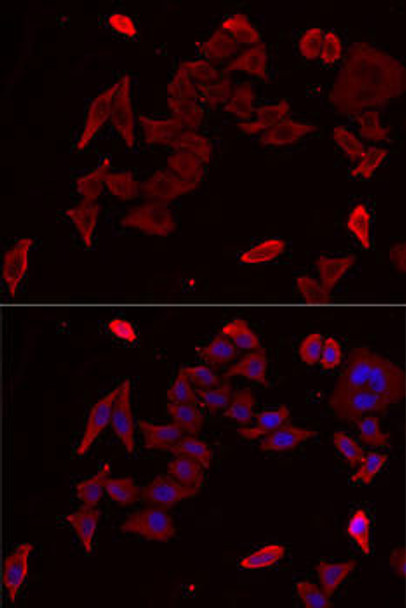Anti-PDHX Antibody (CAB6426)
- SKU:
- CAB6426
- Product type:
- Antibody
- Reactivity:
- Human
- Reactivity:
- Mouse
- Reactivity:
- Rat
- Host Species:
- Rabbit
- Isotype:
- IgG
- Antibody Type:
- Polyclonal Antibody
- Research Area:
- Cell Biology
Frequently bought together:
Description
| 抗体名: | Anti-PDHX Antibody |
| 抗体コード: | CAB6426 |
| 抗体サイズ: | 20uL, 50uL, 100uL |
| 申し込み: | WB IF IP |
| 反応性: | Human, Mouse, Rat |
| 宿主種: | Rabbit |
| 免疫原: | Recombinant fusion protein containing a sequence corresponding to amino acids 1-300 of human PDHX (NP_003468.2). |
| 申し込み: | WB IF IP |
| 推奨希釈: | WB 1:500 - 1:2000 IF 1:10 - 1:100 IP 1:50 - 1:200 |
| 反応性: | Human, Mouse, Rat |
| ポジティブサンプル: | SW620, HepG2, U-251MG, MCF7, Mouse heart, Mouse testis, Mouse brain, Rat kidney, Rat heart |
| 免疫原: | Recombinant fusion protein containing a sequence corresponding to amino acids 1-300 of human PDHX (NP_003468.2). |
| 精製方法: | Affinity purification |
| ストレージバッファ: | Store at -20'C. Avoid freeze / thaw cycles. Buffer: PBS with 0.02% sodium azide, 50% glycerol, pH7.3. |
| アイソタイプ: | IgG |
| 順序: | MAAS WRLG CDPR LLRY LVGF PGRR SVGL VKGA LGWS VSRG ANWR WFHS TQWL RGDP IKIL MPSL SPTM EEGN IVKW LKKE GEAV SAGD ALCE IETD KAVV TLDA SDDG ILAK IVVE EGSK NIRL GSLI GLIV EEGE DWKH VEIP KDVG PPPP VSKP SEPR PSPE PQIS IPVK KEHI PGTL RFRL SPAA RNIL EKHS LDAS QGTA TGPR GIFT KEDA LKLV QLKQ TGKI TESR PTPA PTAT PTAP SPLQ ATAG PSYP RPVI PPVS TPGQ PNAV GTFT EIPA SNIR RVIA KRLT ESKS TVPH |
| 遺伝子ID: | 8050 |
| Uniprot: | O00330 |
| セルラーロケーション: | Mitochondrion matrix |
| 計算された分子量: | 29kDa/51kDa/54kDa |
| 観察された分子量: | 54kDa |
| 同義語: | PDHX, DLDBP, E3BP, OPDX, PDX1, proX |
| バックグラウンド: | The pyruvate dehydrogenase (PDH) complex is located in the mitochondrial matrix and catalyzes the conversion of pyruvate to acetyl coenzyme A. The PDH complex thereby links glycolysis to Krebs cycle. The PDH complex contains three catalytic subunits, E1, E2, and E3, two regulatory subunits, E1 kinase and E1 phosphatase, and a non-catalytic subunit, E3 binding protein (E3BP). This gene encodes the E3 binding protein subunit; also known as component X of the pyruvate dehydrogenase complex. This protein tethers E3 dimers to the E2 core of the PDH complex. Defects in this gene are a cause of pyruvate dehydrogenase deficiency which results in neurological dysfunction and lactic acidosis in infancy and early childhood. This protein is also a minor antigen for antimitochondrial antibodies. These autoantibodies are present in nearly 95% of patients with the autoimmune liver disease primary biliary cirrhosis (PBC). In PBC, activated T lymphocytes attack and destroy epithelial cells in the bile duct where this protein is abnormally distributed and overexpressed. PBC eventually leads to cirrhosis and liver failure. Alternative splicing results in multiple transcript variants encoding distinct isoforms. |
| UniProt Protein Function: | PDHX: a mitochondrial protein required for anchoring dihydrolipoamide dehydrogenase (E3) to the pyruvate dehydrogenase complexes (PDHC) of eukaryotes. This specific binding is essential for a PDHC function. Eukaryotic pyruvate dehydrogenase complexes are organized about a core consisting of the oligomeric dihydrolipoamide acetyl-transferase (E2), around which are arranged multiple copies of pyruvate dehydrogenase (E1), dihydrolipoamide dehydrogenase (E3), and protein X bound by non-covalent bonds. Belongs to the 2-oxoacid dehydrogenase family. Contains 1 lipoyl-binding domain. |
| UniProt Protein Details: | Protein type:Mitochondrial Chromosomal Location of Human Ortholog: 11p13 Cellular Component: mitochondrial matrix Molecular Function:transferase activity, transferring acyl groups Biological Process: cellular metabolic process; regulation of acetyl-CoA biosynthetic process from pyruvate; pyruvate metabolic process Disease: Pyruvate Dehydrogenase E3-binding Protein Deficiency |
| NCBI Summary: | The pyruvate dehydrogenase (PDH) complex is located in the mitochondrial matrix and catalyzes the conversion of pyruvate to acetyl coenzyme A. The PDH complex thereby links glycolysis to Krebs cycle. The PDH complex contains three catalytic subunits, E1, E2, and E3, two regulatory subunits, E1 kinase and E1 phosphatase, and a non-catalytic subunit, E3 binding protein (E3BP). This gene encodes the E3 binding protein subunit; also known as component X of the pyruvate dehydrogenase complex. This protein tethers E3 dimers to the E2 core of the PDH complex. Defects in this gene are a cause of pyruvate dehydrogenase deficiency which results in neurological dysfunction and lactic acidosis in infancy and early childhood. This protein is also a minor antigen for antimitochondrial antibodies. These autoantibodies are present in nearly 95% of patients with the autoimmune liver disease primary biliary cirrhosis (PBC). In PBC, activated T lymphocytes attack and destroy epithelial cells in the bile duct where this protein is abnormally distributed and overexpressed. PBC eventually leads to cirrhosis and liver failure. Alternative splicing results in multiple transcript variants encoding distinct isoforms.[provided by RefSeq, Oct 2009] |
| UniProt Code: | O00330 |
| NCBI GenInfo Identifier: | 12643417 |
| NCBI Gene ID: | 8050 |
| NCBI Accession: | O00330.3 |
| UniProt Related Accession: | O00330 |
| Molecular Weight: | |
| NCBI Full Name: | Pyruvate dehydrogenase protein X component, mitochondrial |
| NCBI Synonym Full Names: | pyruvate dehydrogenase complex component X |
| NCBI Official Symbol: | PDHX |
| NCBI Official Synonym Symbols: | E3BP; OPDX; PDX1; proX; DLDBP; PDHXD |
| NCBI Protein Information: | pyruvate dehydrogenase protein X component, mitochondrial |
| UniProt Protein Name: | Pyruvate dehydrogenase protein X component, mitochondrial |
| UniProt Synonym Protein Names: | Dihydrolipoamide dehydrogenase-binding protein of pyruvate dehydrogenase complex; E3-binding protein; E3BP; Lipoyl-containing pyruvate dehydrogenase complex component X; proX |
| Protein Family: | Pyruvate dehydrogenase complex |
| UniProt Gene Name: | PDHX |
| UniProt Entry Name: | ODPX_HUMAN |
View AllClose




